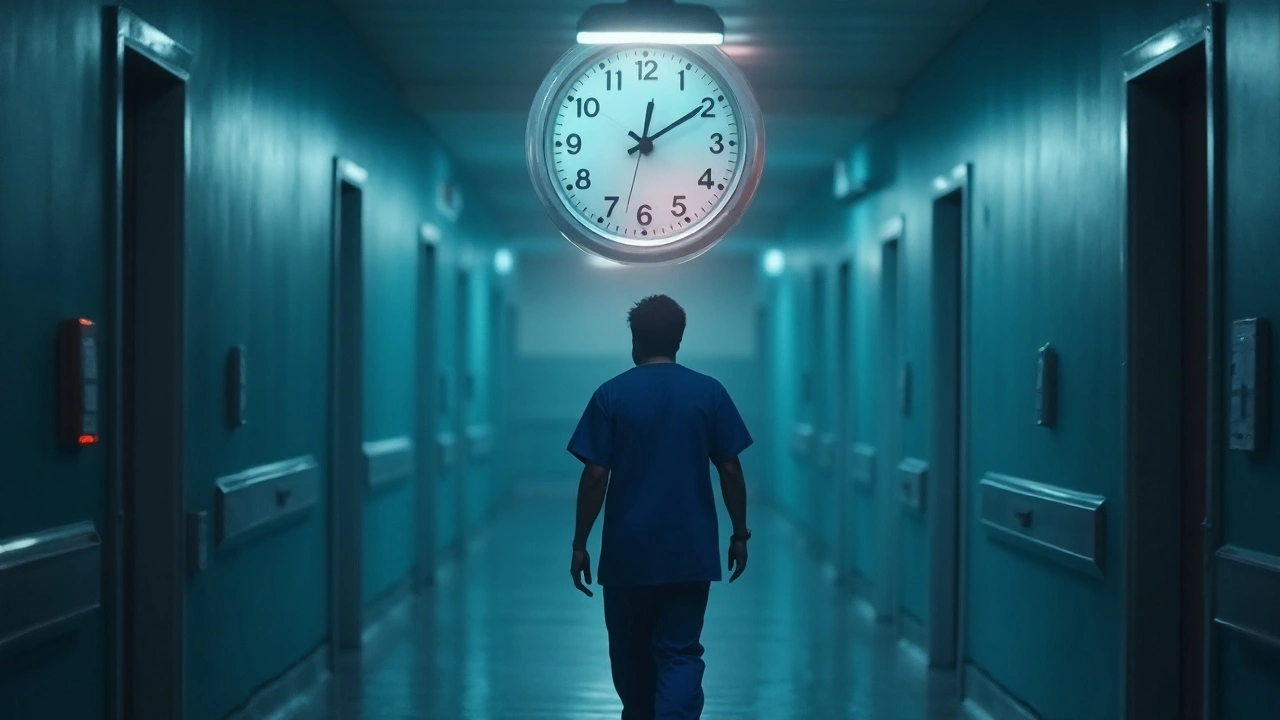Shift‑Work Disorder is a sleep‑wake condition that arises when a person's work schedule conflicts with the natural circadian rhythm, leading to excessive sleepiness, insomnia, and impaired alertness. Prevalence estimates hover around 20% of night‑shift workers in industrial nations, according to the International Sleep Research Society. When the body’s clock is constantly misaligned, a cascade of hormonal and inflammatory changes can amplify existing Chronic Pain, turning a manageable ache into a daily battle.
Quick Takeaways
- Shift‑Work Disorder disrupts melatonin and cortisol, key regulators of pain perception.
- Chronic pain sufferers on rotating shifts report 30‑45% higher pain scores.
- Targeting circadian alignment-light therapy, timed melatonin, stable schedules-cuts pain intensity by up to 25%.
- Employers can lower risk by redesigning shift patterns and offering sleep‑health resources.
- Integrated treatment (sleep hygiene + pain management) yields the best long‑term outcomes.
What Is Shift‑Work Disorder?
Shift‑Work Disorder (SWD) falls under the broader umbrella of Circadian Rhythm disturbances. The human body runs on a roughly 24‑hour cycle governed by the suprachiasmatic nucleus in the brain. When work hours clash with natural light‑dark cues, melatonin secretion is delayed, and cortisol peaks shift, creating a mis‑timed internal clock.
Key attributes of SWD include:
- Insomnia or difficulty staying asleep during the day.
- Excessive sleepiness during work hours.
- Reduced performance and higher accident risk.
- Long‑term health impacts such as cardiovascular disease and metabolic syndrome.
Diagnosis typically follows the International Classification of Sleep Disorders (ICSD‑3) criteria: a work schedule that overlaps the usual sleep window for at least three months, accompanied by clinically significant sleep loss.
Understanding Chronic Pain
Chronic Pain is defined as pain lasting longer than three months or beyond normal tissue healing time. It can be classified into several sub‑types, the most common being Musculoskeletal Pain (e.g., lower‑back or neck pain) and Neuropathic Pain (nerve‑related). Chronic pain is not just a symptom; it involves central sensitization, where the nervous system becomes hyper‑responsive.
Attributes that influence pain severity include:
- Inflammatory markers (CRP, IL‑6).
- Hormonal balance (cortisol, estrogen).
- Psychological factors (stress, depression).
- Sleep quality - poor sleep can raise pain scores by 20‑30%.
Given that up to 50% of adults experience chronic pain at some point, understanding any amplifying factor, like SWD, is crucial.
How Circadian Disruption Links to Pain
The tie between the body clock and pain pathways is mediated through several biochemical players:
- Melatonin - produced at night, it has analgesic and antioxidant properties. Night‑shift workers often have a blunted melatonin surge, reducing its natural pain‑relieving effect.
- Cortisol - peaks in the early morning to promote alertness. Mis‑timed cortisol spikes can increase inflammation and lower the pain threshold.
- Inflammation - cytokines like IL‑1β and TNF‑α follow a circadian rhythm. Disruption amplifies their nocturnal rise, sensitizing peripheral nociceptors.
Research from the Sleep and Pain Laboratory (2023) found that nurses on rotating night shifts displayed a 1.5‑fold increase in IL‑6 levels, correlating with self‑reported pain intensity on the Visual Analog Scale.
Physiological Pathways: From Sleep Loss to Heightened Pain
Three core pathways explain why SWD aggravates chronic pain:
- Neuro‑endocrine dysregulation: Erratic melatonin and cortisol disturb the hypothalamic‑pituitary‑adrenal (HPA) axis, which modulates pain perception.
- Peripheral sensitization: Inflammatory spikes lower the activation threshold of muscle and joint nociceptors, making everyday movements painful.
- Central sensitization: Chronic sleep fragmentation rewires brain regions (insula, anterior cingulate) that amplify pain signals.
These mechanisms are not isolated. For example, reduced melatonin also impairs oxidative stress clearance, further feeding inflammation.

Workplace Factors and Risk Profiles
Not every night‑shift worker develops chronic pain, but certain occupational variables raise risk:
- Shift rotation speed: Fast‑rotating schedules (changing every 2-3 days) cause greater circadian misalignment than slow rotations.
- Physical demand: Jobs that require heavy lifting or prolonged standing while on atypical hours compound musculoskeletal strain.
- Job stress: High perceived stress boosts cortisol, magnifying the pain‑inflammation loop.
- Sleep environment: Poor daylight exposure, noisy bedrooms, and lack of blackout curtains hinder restorative sleep.
Employers can mitigate these factors by offering ergonomic assessments, predictable shift patterns, and dedicated nap rooms.
Assessment and Management Strategies
Addressing the SWD‑pain nexus requires a two‑pronged approach: re‑synchronizing the circadian system *and* treating pain directly.
Sleep‑Centric Interventions
- Light therapy: Bright light exposure (2,500-5,000 lux) for 30minutes at the start of a night shift helps shift the internal clock forward.
- Timed melatonin: 0.5mg taken 30minutes before daytime sleep can boost sleep onset and modestly lower pain scores.
- Sleep hygiene checklist:
- Cool, dark bedroom (use blackout curtains).
- Limit caffeine after the first half of the shift.
- Reserve the bed for sleep only-no screens.
Pain‑Focused Treatments
- Physical therapy that emphasizes core stability and post‑shift stretching.
- Non‑opioid pharmacology (NSAIDs, low‑dose duloxetine) timed to coincide with peak pain periods.
- Cognitive‑behavioral therapy for pain (CBT‑P) to re‑frame catastrophizing thoughts heightened by sleep loss.
Integrated programmes that combine these elements have shown a 22% reduction in disability days among Australian manufacturing workers (2022 longitudinal study).
Comparison Table: Shift‑Work Disorder vs. Other Sleep Disorders
| Attribute | Shift‑Work Disorder | Insomnia | Delayed Sleep Phase Disorder |
|---|---|---|---|
| Primary trigger | Work schedule misalignment | Stress, medical conditions | Biological clock delay |
| Typical onset | After ≥3 months of rotating/night shifts | Sudden or gradual | Adolescence to early adulthood |
| Melatonin pattern | Blunted or delayed rise | Often normal | Significantly delayed peak |
| Impact on chronic pain | ↑ Pain intensity≈30‑45% | Variable, generally lower | Minor, unless combined with sleep loss |
| Best non‑pharmacologic treatment | Light therapy + schedule stability | CBT‑I (cognitive‑behavioral therapy for insomnia) | Chronotherapy (gradual phase advance) |
Related Concepts and Next Steps
Understanding the SWD‑pain link opens doors to broader topics such as Occupational Health, the economics of absenteeism, and emerging chronobiology research. Readers interested in how wearable tech can track circadian metrics may explore “Digital Biomarkers for Sleep‑Related Pain.” Those seeking deeper clinical guidance could look into “Guidelines for Managing Chronic Pain in Shift Workers” published by the American Academy of Pain Medicine.
Frequently Asked Questions
Can a single night shift cause chronic pain?
One isolated night shift is unlikely to trigger chronic pain on its own. However, repeated exposure-especially when combined with heavy physical work-can start the inflammation‑pain cascade that evolves into chronic discomfort over months.
Is melatonin safe for shift workers?
Low‑dose melatonin (0.3‑0.5mg) taken 30minutes before daytime sleep is generally safe and has minimal side effects. Higher doses can cause grogginess and may interfere with the body’s natural cortisol rhythm, so it’s best to start low and consult a clinician.
How long does it take to reset my circadian rhythm?
Re‑entrainment typically requires 1-2weeks of consistent light exposure, melatonin timing, and stable sleep‑wake windows. Faster rotation schedules prolong the adjustment period, sometimes extending to several months.
Do employers have a legal duty to address shift‑work disorder?
In many jurisdictions, occupational health regulations require employers to assess and mitigate work‑related health risks, including sleep disorders. While specific legislation varies, best practice guidelines from bodies like the International Labour Organization recommend schedule design that limits excessive night‑shift exposure.
What role does exercise play in this context?
Regular moderate exercise improves sleep quality, reduces inflammation, and enhances pain thresholds. For shift workers, timing matters-light‑intensity workouts during the night shift can boost alertness, while heavy exercise close to sleep may impair daytime rest.


13 Comments
McKayla Carda
My sister works ER nights and swore off opioids after starting timed melatonin and blackout curtains. Her pain scores dropped 40% in 6 weeks. This isn’t theory-it’s survival.
Eric Pelletier
For anyone diving into this: the HPA axis dysregulation in SWD isn’t just about cortisol spikes-it’s the loss of diurnal cortisol slope that really screws with nociceptive gating. Add in IL-6’s circadian amplification and you’ve got a perfect storm for central sensitization. The 25% pain reduction from light therapy? That’s not placebo. That’s neuroendocrine recalibration.
Howard Lee
Just wanted to say thank you for writing this. As a night-shift nurse with chronic lower back pain, I’ve been told it’s ‘just stress’ for years. This explains exactly what’s happening in my body. I’m starting light therapy tomorrow.
Hadrian D'Souza
Oh wow. Another ‘circadian rhythm’ miracle cure. Next they’ll tell us the moon controls our pain levels. Wake up. People have had chronic pain since before we had clocks. You’re overcomplicating a simple problem with jargon and pretending it’s new science.
Robert Gallagher
Listen. I’ve been on rotating shifts for 14 years. Back pain? Yeah. But here’s what actually helped: no caffeine after 2pm, nap before shift, and stretch every 90 minutes. No fancy light boxes. Just common sense. Stop selling snake oil. Also-your table comparing disorders? That’s gold.
Robert Spiece
You know what’s really ironic? We’ve spent billions mapping the human genome but still think a 0.5mg melatonin pill will fix a system designed by evolution to sync with sunlight. We’re not broken-we’re out of phase. And no, your ‘integrated program’ won’t fix a society that treats sleep like a luxury. This isn’t medicine. It’s damage control for capitalism’s sleep debt.
Nicole Carpentier
I’m from Brazil but work a night shift in Chicago. The hardest part isn’t the pain-it’s the loneliness. No one gets it unless they’ve slept in daylight with sirens outside. I started using my phone as a blue light blocker and now I sleep 5 hours straight. Small wins.
Christopher Ramsbottom-Isherwood
Let me guess-next you’ll say caffeine timing affects pain perception too. Oh wait, you already did. This article reads like a pharmaceutical whitepaper dressed up as public health advice. Where’s the data on long-term outcomes beyond 6 months? Where’s the control group? This feels like a product pitch disguised as science.
Vivian Quinones
My husband works security. He says his back kills him after night shifts. I told him to just sleep more. He said he can’t. Now I get it. This isn’t laziness. It’s biology. I’m printing this out for his boss.
Elliott Jackson
They say melatonin helps. But have you tried taking it when your body thinks it’s 3 PM? It’s like trying to meditate in a nightclub. And don’t get me started on ‘sleep hygiene’-try sleeping when your kid is screaming and the AC unit sounds like a jet engine. This is rich people advice for poor people’s problems. 🤷♂️
Abhay Chitnis
India has 12 million shift workers. No light therapy. No melatonin. Just painkillers and prayer. Why are we pretending this is a Western problem? Your ‘integrated programs’ won’t work here. We need fair wages, not wellness apps.
Stacy Reed
What if the real issue isn’t the shift? What if it’s that we’ve lost the ritual of rest? Our ancestors slept in two blocks, with quiet time in between. We don’t rest-we consume. We scroll. We stress. The body isn’t broken. The culture is. And no pill or light box can fix that. We’ve forgotten how to be still.
Brandon Benzi
So now we’re blaming capitalism for back pain? Cool. Next they’ll say the patriarchy caused insomnia. Look, I’m a veteran. I’ve worked nights for 20 years. Pain? Yeah. But I didn’t get it because of melatonin-I got it because I lifted heavy stuff for 12 hours. Stop overthinking it. Fix the job, not the clock.